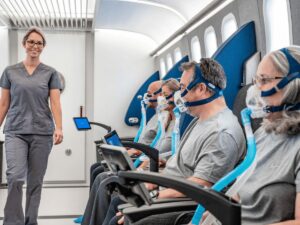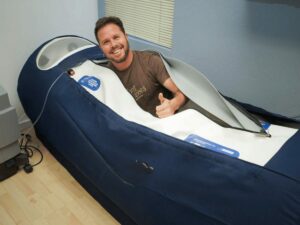What is the mechanism of action of Hyperbaric Oxygen Therapy? The magic behind this is it works by boosting oxygen levels in the body more than usual air can.
With a decade-long track record of delivering expert advice and the latest insights in hyperbaric therapy. Our expertise ensures giving information that’s both accurate and relevant to the industry.
In this guide, we’ll delve into the scientific principles behind HBOT, exploring how increased atmospheric pressure and oxygen levels can lead to remarkable health benefits.
Keep reading to discover!
1. Understanding Hyperbaric Oxygen Therapy
Hyperbaric Oxygen Therapy (HBOT) stands as a remarkable medical treatment, utilizing pressurized oxygen to foster healing and combat infection. Within the confines of a hyperbaric chamber, patients breathe in pure oxygen at pressures higher than atmospheric levels. This process significantly increases the amount of oxygen delivered to the body’s tissues.
HBOT doesn’t just deliver oxygen more efficiently, it also triggers physiological responses that are pivotal for recovery. Understanding HBOT’s foundational principles becomes essential in harnessing its full potential. No doubt that the anticipated growth rate for hyperbaric oxygen therapy devices is 7.0% annually, with an estimated value of approximately US$ 6.86 billion by 2033, as per FMI.
2. The Mechanism of Action Explained
Building on understanding of Hyperbaric Oxygen Therapy (HBOT), it’s time to dive deeper into how it actually works. Here are the mechanisms that make HBOT a cornerstone of modern therapeutic practices:
Anti-inflammatory Response
HBOT provokes a powerful anti-inflammatory response within the body. By reducing inflammation, HBOT helps to alleviate pain and swelling, creating an environment that fosters healing. This mechanism is crucial for treating conditions like chronic wounds, where inflammation impedes natural recovery processes.
Angiogenesis Stimulation
One of the most exciting aspects of HBOT is its ability to stimulate angiogenesis. This is essential for healing in areas with restricted blood flow, ensuring that more oxygen and nutrients reach tissues in need. This process underpins the therapy’s effectiveness in treating diabetic foot ulcers and enhancing recovery from radiation damage.
Antimicrobial Effect
Lastly but not the least, HBOT has a potent antimicrobial effect. The high levels of oxygen delivered to tissues during treatment have been shown to kill bacteria and inhibit the growth of certain fungi and viruses. This aspect is particularly beneficial for fighting infections in non-healing wounds, showcasing HBOT’s dual role in both healing and infection control.
| Microorganism |
Effect of HBOT |
| Bacteria |
HBOT delivers high levels of oxygen, effectively killing bacteria in non-healing wounds. |
| Fungi |
Certain fungi are inhibited from growing due to the oxygen-rich environment created by HBOT. |
| Viruses |
HBOT has shown promise in inhibiting the growth of specific viruses, contributing to infection control. |
| Wound Infections |
The antimicrobial properties of HBOT aid in combating infections, facilitating wound healing. |
| Multi-Drug Resistant Organisms (MDROs) |
HBOT exhibits effectiveness against MDROs, offering an alternative approach in managing resistant infections. |
3. Physiological Effects of HBOT
Following the exploration of the mechanism of action behind Hyperbaric Oxygen Therapy (HBOT), it becomes even more fascinating when we consider the physiological effects it has on the human body. Here are the transformative impacts of HBOT:
Boosted Immune Response
By increasing oxygen levels, HBOT strengthens the body’s immune system. Oxygen acts as a natural antibiotic, helping white blood cells kill bacteria more effectively and reducing the risk of infection. This is critical in managing wounds that are difficult to heal, providing a dual benefit of healing and protection against infection.
Reduced Edema and Inflammation
One of the immediate benefits of HBOT is the reduction of swelling and inflammation. By decreasing the formation of edema and improving oxygenation, the body can reduce the inflammatory response, leading to decreased pain and faster recovery times. This effect is a game-changer for patients suffering from chronic inflammatory conditions.
Accelerated Wound Healing
The increased oxygen supply and reduced inflammation significantly accelerate wound healing. HBOT promotes the formation of new blood vessels and enhances collagen synthesis, which are crucial for wound repair. And the best part is, this process not only speeds up healing but also improves the quality of scar tissue, leading to better outcomes for patients with chronic wounds or undergoing surgery.

4. Clinical Applications of HBOT
Diving into the physiological effects of Hyperbaric Oxygen Therapy (HBOT) sheds light on its transformative power for a myriad of health conditions. Here are some key areas where HBOT is making a profound difference:
Diabetic Foot Ulcers
HBOT has emerged as a cornerstone in the management of diabetic foot ulcers, where poor circulation and high risk of infection pose significant challenges. By enhancing oxygen delivery to compromised tissues, HBOT accelerates wound healing and significantly reduces the risk of amputation. This application not only improves patient outcomes but also addresses a major complication of diabetes, offering a new lease on life for many.
Decompression Sickness
Traditionally associated with divers, decompression sickness results from the formation of gas bubbles in the bloodstream during rapid ascents. HBOT effectively reduces the size of these bubbles and helps dissolve them, mitigating the risk of embolism and other severe complications. It’s a critical intervention for affected individuals, turning potential tragedy into manageable conditions.
Severe Anemia
For patients who cannot receive blood transfusions, HBOT presents a lifesaving alternative. By saturating blood plasma with oxygen, it ensures vital organs receive enough oxygen to function properly until other treatments become viable. This application of HBOT showcases its versatility and capacity to provide critical support in life-threatening situations.
Chronic Refractory Osteomyelitis
Chronic refractory osteomyelitis often resistant to standard treatments, find a formidable opponent in HBOT. The therapy’s ability to penetrate deep into affected bone tissues and enhance the efficacy of antibiotics leads to improved outcomes. And the best part is, HBOT offers hope where traditional treatments have failed, marking a significant advance in the fight against persistent bone infections.

5. Operational Aspects of HBOT
Exploring the clinical applications of Hyperbaric Oxygen Therapy (HBOT) reveals its potential to revolutionize patient care. However, effectively integrating HBOT into practice requires understanding its operational aspects. Here are the critical components to consider when implementing HBOT in a clinical setting:
Chamber Types and Specifications
There are two primary types of hyperbaric chambers,monoplace, designed for a single patient, and multiplace, which can accommodate multiple patients or a healthcare provider. Monoplace chambers are typically pressurized with pure oxygen, while multiplace chambers use compressed air. Each type has its advantages, tailored to specific treatment needs. Additionally, for the best quality chambers, I recommend Oxygen-Ark.
Safety Protocols and Training
Safety is paramount in HBOT operations. Comprehensive training for all personnel is essential to prevent and manage potential risks, including oxygen toxicity and fire hazards. Facilities must adhere to strict guidelines, ensuring chambers are operated and maintained according to the highest safety standards. Remember, when safety protocols are meticulously followed, HBOT can be a safe, transformative therapy.
Treatment Protocols
HBOT sessions vary in duration and frequency, typically lasting between 60 to 120 minutes and occurring once or twice daily. The specific protocol depends on the condition being treated, with a course of treatment ranging from a few sessions to over 40. Personalized treatment plans are crucial, as they adapt protocol specifics to maximize therapeutic outcomes for each patient.

6. Challenges and Considerations in HBOT
Delving into the operational aspects of Hyperbaric Oxygen Therapy (HBOT) opens up a dialogue on its practical challenges and considerations. I believe that ensuring HBOT’s success involves navigating these hurdles with strategic foresight. Here are key challenges and considerations HBOT providers must address:
Accessibility and Cost
Despite its benefits, HBOT remains inaccessible to many due to high operational costs and limited insurance coverage. Facilities must balance between offering cutting-edge treatments and managing expenses to keep affordable for patients. They should look for quality but budget friendly chambers just like what Oxygen-Ark is offering. This financial balancing act is critical in expanding HBOT’s reach.
Patient Compliance and Comfort
Ensuring patient comfort and compliance during HBOT sessions, which can last up to two hours, is a challenge. Claustrophobia or discomfort in the chamber can deter patients from completing their treatment regimen. To address this innovative solutions like for example personalized entertainment systems and comfort-focused chamber designs, are vital in enhancing patient experience and treatment efficacy.
Technical and Staffing Requirements
HBOT requires specialized training for operators and healthcare providers, emphasizing safety and patient care. The shortage of trained personnel can limit a facility’s ability to offer HBOT. Investing in comprehensive training programs is essential for maintaining high standards of care and operational efficiency.

7. Innovations and Future Directions in HBOT
Reflecting on the challenges and considerations in Hyperbaric Oxygen Therapy (HBOT) illuminates the path forward, showcasing the potential for innovation and improvement. Here are the innovations and future directions shaping the next generation of HBOT:
Portable Hyperbaric Chambers
The development of portable and more affordable hyperbaric chambers is revolutionizing access to HBOT. These innovations mean treatment could be administered in various settings, including patients’ homes, making it more convenient and potentially increasing compliance. Amazing isn’t it? It’s a significant leap towards democratizing this powerful therapy for wider use.
Personalized Treatment Protocols
Advancements in personalized medicine are finding their way into HBOT, with research focusing on tailoring treatments to individual patient needs. By analyzing patient data and outcomes, clinicians can optimize oxygen levels and session duration to maximize efficacy. This precision approach promises to enhance treatment outcomes significantly.
Integration with Telemedicine
The integration of HBOT with telemedicine platforms is enhancing patient monitoring and support. For example, patients undergoing HBOT can receive real-time consultations and post-treatment care remotely, improving the continuity of care. This integration also facilitates the sharing of treatment data among healthcare providers, fostering a more collaborative approach to patient wellness.

Dive Deeper Into Our Resources
Looking for more diverse product options? Browse through our handpicked selections:
Still haven’t found what you’re looking for? Don’t hesitate to contact us. We’re available around the clock to assist you.
Conclusion
Hyperbaric Oxygen Therapy stands at the crossroads of innovation and tradition, offering new hope and advanced treatment options across a wide array of medical conditions. As we’ve explored, from its mechanisms it is evolving to meet the needs of patients and healthcare providers alike.
For those interested in exploring the benefits of HBOT further, Oxygen-Ark, a leading manufacturer of hyperbaric chambers, offers state-of-the-art solutions tailored to your specific needs. Contact us today!





